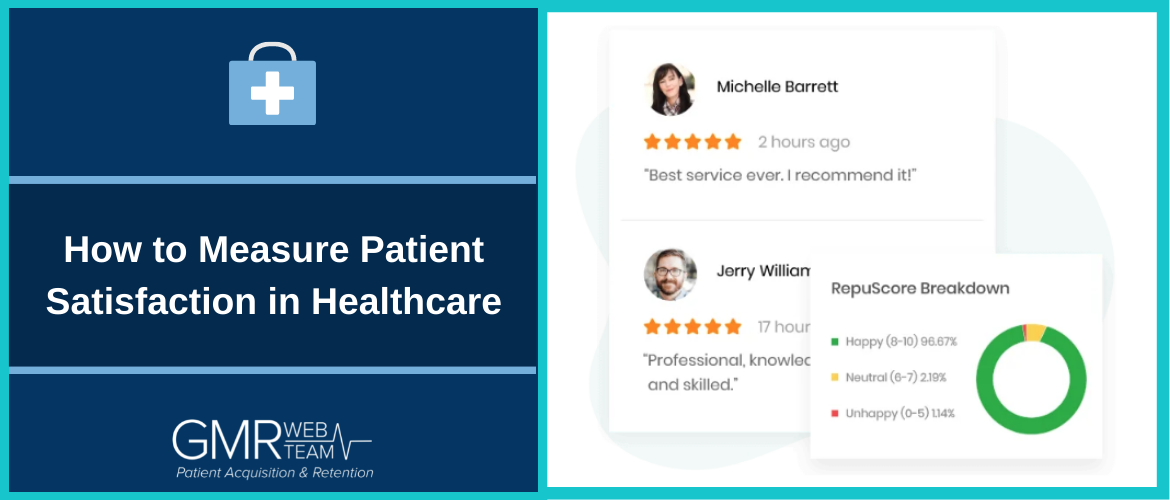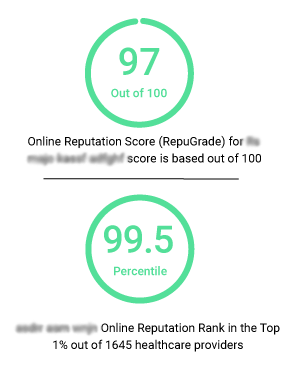How to Measure Patient Satisfaction in Healthcare

Satisfaction is a strong motivating factor in producing loyal, returning patients. Therefore, it is important to measure your patient satisfaction levels to make any necessary adjustments that will benefit both your patients and your practice.
There are benefits to both the practice and the patient when satisfaction levels are high. For example, patients experience increased levels of trust, a greater sense of loyalty, and better health outcomes.
Healthcare practices with high patient satisfaction rates experience improved patient acquisition and retention, better practice reputation, and higher staff morale.
Here are some ways to measure patient satisfaction in a healthcare practice.
#1. Patient Satisfaction Surveys
A patient satisfaction survey is a curated list of questions about a patient’s full experience with your medical practice, from initial contact through the end of their visit and beyond. This provides measurable data on exactly where your practice can improve whether that’s your bedside manner, front desk staff, or how the phones are handled.
#2. Behavioral Observation
You can learn a lot about how patients are feeling about your practice by simply observing their behavior. You and your staff can measure patient satisfaction by watching how patients are interacting with staff, doctors, each other, and even how they are acting alone.
Observe how they behave in different situations, such as when they are sitting in the waiting room or transacting a payment for their visit. Are they happy, neutral, annoyed, confused? Observe and take note of what you see.
#3. Follow-Up Communication
Patient satisfaction can also be measured when following up with patients after a visit. Whether they had a procedure or are due for another visit soon, following up with patients is a great time to gauge how they are feeling about your practice.
Whether by phone, SMS, email, or snail mail, it’s always a good practice to follow up with patients.
#4. Track and Monitor Referrals
Patients who refer others to your practice are clearly satisfied with the care they received. However, make sure to figure out what it is exactly that you are doing right. For example, are patients referring others for a few select services? Why is that? Analyzing your patient referrals is a great way to figure out what is working (and what is not).
#5. Monitor Online Reviews and Ratings
Both satisfied and dissatisfied patients will leave online reviews. Having staff keep their eye on reviews as they come in can provide a real-time glimpse into how patients feel after their visit.
Google and other healthcare review sites like RateMDs and Vitals, etc., aggregate an average star rating out of five based on all the ratings added by the reviewers and will update as soon as a new review is posted. Keeping an eye on your star rating shows you a general measure of patient satisfaction.
#6. Communicate with Staff
Make it a practice to check in with the staff that interact most with patients. Most likely, Patients have provided positive and negative feedback that may not have been written in a review or shared with the proper person. Asking staff about the feedback they’ve been hearing directly from patients can help you measure patient satisfaction.
#7. Develop a Satisfaction Team
Dedicate a few staff members as the patient satisfaction team. Their role is to monitor patient reviews, review survey results, and keep an up-to-date idea on how patients are feeling and why they’re feeling that way. This team can then meet on a consistent basis and share their findings.
#8. Set up Feedback Touchpoints
It can be difficult to get ahold of patients for their feedback after they leave your office. Try setting up places around the office where they can quickly leave a review after their visit, such as a kiosk or dedicated tablet/computer.
#9. Train Staff to Ask
Have staff ask patients how their visit is going, or how it went at the end. For example, nurses can ask about a patient’s visit halfway through, and front desk staff can ask once more when the patient is checking out. Staff can then report back on what they are hearing from patients and advise any changes necessary to improve patient satisfaction.
#10. Track All Feedback in One Place
With many moving parts in measuring patient satisfaction, it is important to have a single source where all patient feedback is logged and stored. This could be through patient engagement software dashboard or even a dynamic online document.
#11. Hold Regular Meetings
Regular meetings with staff not only benefit morale, but can also be a great time to get an idea of how they think patients are feeling and what can be done to improve practice operations.
#12. Streamline Your Patient Recovery Process
Dissatisfied patients often feel frustrated by how they were treated and are hoping the practice will make things right. Streamlining your patient recovery process - identifying negative feedback and reaching out to the patient - is important for measuring and improving patient satisfaction.
Using an automated tool can aid in patient service recovery as well, notifying practices of unhappy patients and documenting all feedback in one convenient place. After the patient service recovery process, you can even measure the success of your outreach to advise on future strategy.
#13. Track Office Improvements
Whenever an improvement is made, consider tracking what was done along with patient feedback. This can show you any sort of ROI on upgrades, improvements, and any other change made that affects the patient experience. This can show if a change is working and how patients feel.
#14. Allow Multi-Channel Feedback
Chances are, your patient base is diverse. They may not all be savvy with smartphones, web browsers, etc., so allowing multiple channels for patient feedback is important. For example, a patient who prefers filling out a survey in an email may not respond well to a survey via phone call.
#15. Implement AI-Based Software
Software and other automated technology can greatly help in measuring patient satisfaction. Some automated tools can help track and analyze patients' sentiments and that’ll help you to measure patient satisfaction at your practice.
Conclusion:
The more you get to know about your patient satisfaction levels, the more you will learn about your practice's strengths and the areas that need improvements. So make use of the ways mentioned above to gather and analyze the information on patient experience and patient satisfaction. It will help you attract new patients and retain your existing ones to build and own a loyal patient base.
Related Posts:
22 Creative Ways to Increase Patient Satisfaction
Top Patient Satisfaction Survey Questions You Should Ask
Comments are closed


